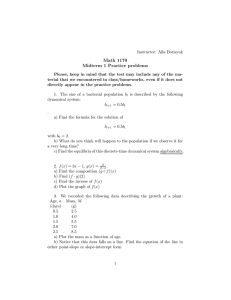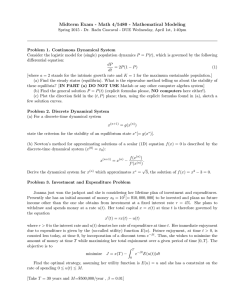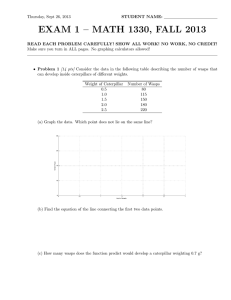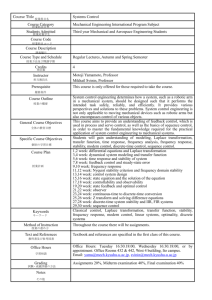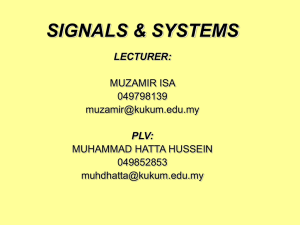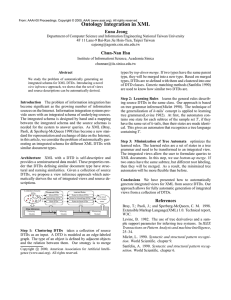Math 155. Homework 2. Sections 1.5-1.7 1.5: 59
advertisement
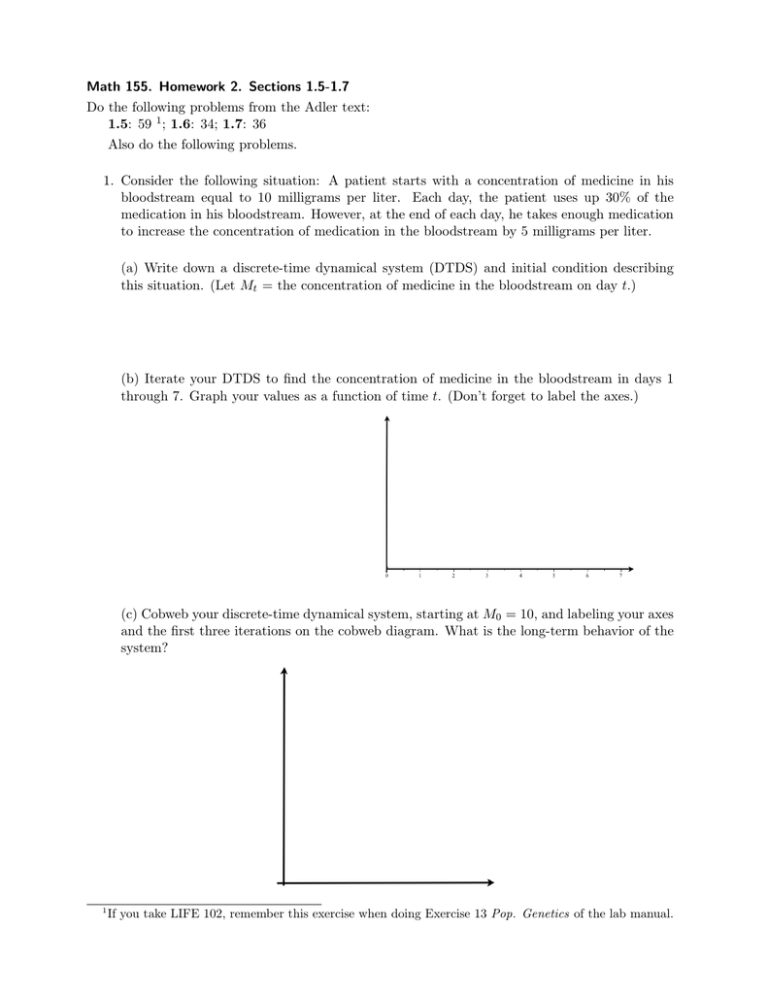
Math 155. Homework 2. Sections 1.5-1.7 Do the following problems from the Adler text: 1.5: 59 1 ; 1.6: 34; 1.7: 36 Also do the following problems. 1. Consider the following situation: A patient starts with a concentration of medicine in his bloodstream equal to 10 milligrams per liter. Each day, the patient uses up 30% of the medication in his bloodstream. However, at the end of each day, he takes enough medication to increase the concentration of medication in the bloodstream by 5 milligrams per liter. (a) Write down a discrete-time dynamical system (DTDS) and initial condition describing this situation. (Let Mt = the concentration of medicine in the bloodstream on day t.) (b) Iterate your DTDS to find the concentration of medicine in the bloodstream in days 1 through 7. Graph your values as a function of time t. (Don’t forget to label the axes.) (c) Cobweb your discrete-time dynamical system, starting at M0 = 10, and labeling your axes and the first three iterations on the cobweb diagram. What is the long-term behavior of the system? 1 If you take LIFE 102, remember this exercise when doing Exercise 13 Pop. Genetics of the lab manual. (d) Find any equilibria for your discrete-time dynamical system algebraically. (e) Now consider the discrete-time dynamical system with parameters Mt+1 = (1 − α)Mt + g. What are the interpretations of the parameters α and g in the medicine example? What are the dimensions of the parameters α and g if Mt = concentration of medicine in miligrams per liter? (f) Find the equilibrium of the DTDS in (e) algebraically. What happens to the eqilibrium if the values of both α and g are cut in half? (g) In Section 1.9, you will build a DTDS for the concentration ct of a chemical in your lung after you inhale and exhale t times in a room containing that chemical. The DTDS is ct+1 = (1 − q)ct + qγ, where q is the fraction of air in the lung exchanged each time you inhale and exhale and γ is the concentration of the chemical in the ambient air in the room. Find all equilibria of this DTDS algebraically. Explain why your result makes sense. (Notice how similar in form this DTDS is to the Medicine DTDS!) 2. Growing Duckweed. This exercise and the discussion of exponential growth in Sections 1.5 and 1.7 are relevant to Section 53.3 “The exponential model describes population growth in an idealized, unlimited environment” of the LIFE 102 text Biology by Campbell and Reece. The table and graph below show the results of an experiment in which duckweed fronds (large compound leaves) growing in a pond were counted weekly 2 . (a) Compute N1 = N0 , N2 = N1 , N3 = N2 , N4 = N3 , N5 = N4 (b) Data will never fit a mathematical discrete-time dynamical system exactly. The graph of the data indicates, however, that the process of duckweed growth can be approximated by a discrete-time dynamical system of the form Nt+1 = rNt for some r. Using your results in part (a), choose a reasonable value of r for these data. (Note: Since r = Nt+1 /Nt , where both Nt+1 and Nt measure the number of duckweed fonds, r is a dimensionless quantity!) (c) Use your discrete-time dynamical system to estimate N8 . 2 “Some accessory factors in plant growth and nutrition.” by W. B. Bottomley, Proceedings of the Royal Society B 88, 1914, pg. 237-247. Adapted from D. Lomen and D. Lovelock, Differential Equations, John Wiley and Sons, 1999. (d) Write down a solution for your discrete-time dynamical system. (e) Use the solution to your discrete-time dynamical system to predict the time at which there will be 2000 duckweed fronds in the pond. (f) What do the discrete-time dyanamical system and your solution predict will happen as many weeks go by and t gets very large? Is this reasonable biologically? What are some limiting biological/ecological factors will eventually come into play? (We will discuss these factors and the logistic discrete-time dynamical system that takes them into account in Section 3.2. This is also discussed in Section 53.4 “The logistic model describes how a population grows more slowly as it nears its carrying capacity” of Biology by Campbell and Reece. You will see both the exponential growth model and the logistic model again if you take BZ 220 Introduction to Evolution or BZ 320 Ecology.)
